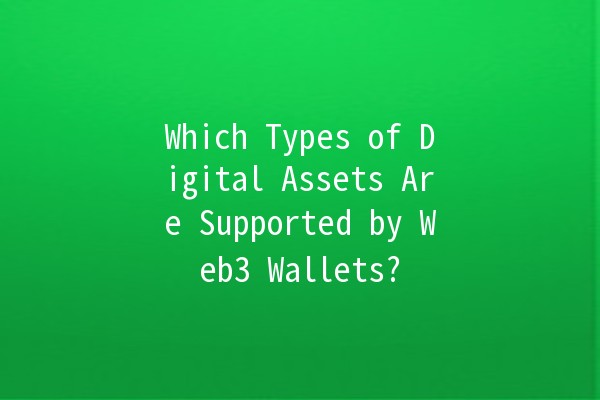




As the digital landscape evolves, the term "Web3" has emerged as a transformative approach to the internet, introducing decentralized applications and blockchain technology. At the heart of this revolution are Web3 wallets, crucial tools allowing users to manage their digital assets securely. In this article, we'll explore the types of digital assets supported by Web3 wallets, providing practical insights and tips to help you navigate this exciting new ecosystem.
A Web3 wallet is a cryptocurrency wallet that allows users to interact with decentralized applications (dApps) and other blockchainbased services. Unlike traditional wallets, which are usually centralized, Web3 wallets give users full control over their private keys, enhancing security and allowing for greater autonomy over digital assets.
Digital assets are essential to the Web3 ecosystem as they facilitate transactions, enable decentralized finance (DeFi), and serve as a medium of exchange within various blockchain networks. Understanding the types of digital assets supported by Web3 wallets is crucial for anyone looking to engage with this new digital frontier.

Web3 wallets typically support a wide variety of digital assets. Here are some of the main categories:
Description: These are the native currencies of blockchain networks used for transactions, investments, and DeFi activities.
Examples:
Bitcoin (BTC): The original cryptocurrency, often regarded as digital gold.
Ethereum (ETH): The secondlargest cryptocurrency, which enables smart contracts and dApps.
Application: Web3 wallets allow users to send and receive cryptocurrencies, participate in staking, and trade on decentralized exchanges (DEXs).
Description: Tokens are digital assets created on existing blockchain platforms, often representing assets or utilities within specific ecosystems.
Examples:
ERC20 Tokens: Tokens built on the Ethereum blockchain, such as Chainlink (LINK) and Uniswap (UNI).
BEP20 Tokens: Tokens on the Binance Smart Chain, like PancakeSwap (CAKE).
Application: Users can store, trade, and utilize tokens for a variety of purposes, such as governance voting or accessing services.
Description: NFTs are unique digital assets representing ownership of specific items, including art, music, and collectibles.
Examples:
CryptoKitties: One of the first NFT projects representing digital cats.
Art Blocks: A platform for algorithmically generated art NFTs.
Application: Web3 wallets allow users to buy, sell, and showcase their NFTs on marketplaces, facilitating the growing digital art and collectibles market.
Description: Stablecoins are cryptocurrencies pegged to a stable asset, usually a fiat currency, to minimize volatility.
Examples:
Tether (USDT): Pegged to the US dollar, widely used in trading.
USD Coin (USDC): Another US dollarpegged stablecoin, known for its transparency.
Application: Users leverage stablecoins for trading, as a medium of exchange, and to earn interest in various DeFi protocols.
Description: Governance tokens give holders voting rights within a decentralized organization or protocol.
Examples:
Maker (MKR): Used for governance in the MakerDAO ecosystem.
Aave (AAVE): Grants voting power for changes in the Aave protocol.
Application: Holding governance tokens allows users to influence project decisions and future developments within the platform.
To enhance productivity and security while using Web3 wallets, consider the following strategies:
Explanation: Using MFA provides an additional layer of security, ensuring only authorized users can access the wallet.
Example: Platforms like MetaMask and Trust Wallet support MFA, which can significantly reduce the risk of unauthorized access to your assets.
Explanation: Keeping your wallet software up to date minimizes vulnerabilities that could be exploited by malicious actors.
Example: Ensure that you download wallet updates directly from official sources to prevent phishing attacks.
Explanation: A diversified portfolio spreads risk across various digital assets, potentially increasing overall returns.
Example: Consider holding a mix of cryptocurrencies, tokens, and NFTs, balancing between established assets and emerging projects.
Explanation: Engaging in DeFi can provide additional income opportunities through lending, staking, and liquidity provision.
Example: Use your Web3 wallet to connect with platforms like Aave or Compound for lending out your assets and earning interest.
Explanation: Your private keys are the gateway to your digital assets; losing them means losing access.
Example: Use hardware wallets for added security, as they store private keys offline, reducing exposure to online threats.
Choosing a Web3 wallet depends on factors like security, ease of use, and supported assets. Consider wallets like MetaMask for Ethereumbased assets or Trust Wallet for multichain support.
Web3 wallets can be secure, but the safety largely depends on the user's practices. Utilize strong passwords, enable MFA, and keep your software updated.
Yes, many Web3 wallets offer mobile applications, allowing easy access to manage digital assets on the go. Popular mobile wallets include Trust Wallet and Coinbase Wallet.
If you lose access, the recovery process depends on whether you have your recovery phrase. Always store this phrase securely, as it is the key to recovering your assets.
Many Web3 wallets facilitate swaps between assets through integrated decentralized exchanges, allowing you to trade directly without leaving the wallet interface.
Web3 wallets empower users with control over their digital assets, enabling interaction with dApps and participating in governance, which is foundational to the decentralized ethos.
By understanding the types of digital assets supported by Web3 wallets and implementing effective strategies, users can greatly enhance their experience in the decentralized web. Whether you are a novice or an experienced user, staying informed about the everevolving landscape of digital assets ensures that you navigate the Web3 ecosystem with confidence and security.